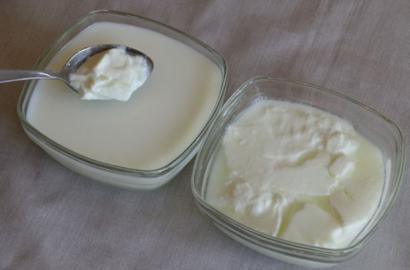Homemade Yogurt
When I refer to “plain yogurt” as an ingredient, I mean the kind that has been made for thousands of years in Vedic kitchens using whole milk, sometimes even thin cream or top milk, and a starter –nothing else. Most supermarket yogurt is made from low-fat milk, skimmed milk and even reconstituted powdered milk, and does not even resemble the custard-like smooth yogurt found in India, Greece and Middle East. Yogurt is easy to make, it is economical, and it lends character to a multitude of Vedic dishes. If you are pressed for time and prefer to use commercial yogurt, many health food stores and delicatessens carry whole milk yogurt, and some, like Brown Cow and Columbo, are very good. They also make the best starters.
Because yogurt is no more than a transformation of milk, it possesses the same food value. Although the importance of fresh milk cannot be emphasized, it is the butterfat content that makes for the appreciable differences in body and texture. Whole cow’s milk averages 3.25-3.8 percent butterfat, Guernsey and jersey milk tops 4.2 percent, while half-and-half runs about 12 percent. In India today, buffalo milk, with about 8.2 percent butterfat, is widely used for commercial yogurt. Because I was never fond of its cloying strong taste, I preferred to make my own by boiling cow’s milk to reduce it to three-quarters its original volume, ending up with a consistency similar to thick buffalo yogurt. Any yogurt made from unpasteurized milk has a creamy top layer of malai a crust that solidifies on the surface of the milk which is delicious and can be used a number of ways. When I want to make a firm-bodied yogurt, without the extra calories of whole milk, I add non-fat, non-instant powdered milk to 2 percent milk; the milk powder lends a touch of both sweetness and body. Homemade yogurt is not sweetened, but is both so mild and mellow that many refer to it as tasting sweet. It is a far cry from the often tangy, watery, tart commercial yogurt loaded with unnecessary stabilizers and fillers such as gelatin, locust bean gum, cellulose and carrageenan.
Yogurt has always been a guardian of good health. It is a source of calcium, protein, fat, carbohydrates, phosphorus, vitamin A, the B complex vitamins and vitamin D. it encourages the growth of benign intestinal bacteria that aid digestion and help to destroy the harmful bacteria that are alleged to spawn a variety of illnesses. The lactic acid content helps to digest and assimilate calcium and phosphorus, and yogurt is certainly easier to digest than milk. In one hour, 32 percent of milk can be digested, compared to 91 percent of yogurt. As a rule, yogurt beverages and salads are taken during the hot summer months, and when the fire of digestion increases in the winter, the frequency of milk dishes is increased in the diet.
The starter is nothing more than a little homemade or commercial plain yogurt. It is live bacteria, and must be fresh and sweet; tart and sour starters will yield tart and sour yogurt. Most starters combine Lactobacillus burglarious and Streptococcus thermophilus, but I prefer a culture including L. acidophilus, which yields a mild yogurt known to be beneficial.
Yogurt not only flavors, it thickens, enriches and tenderizes. It is the basis of a multitude of Vedic dishes, from creamy chilled lassi beverages to nutritious yogurt salads called raitas. Drained of its whey, it turns into a low calorie cream cheese called dehin, which, sweetened, becomes an elegant Maharastrian dessert known as shrikhand.
Preparation time (after assembling ingredients): 20 minutes
Setting time: 4-10 hours
Ingredients
• Non-instant, non-fat dry milk powder (optional) – ½ cup (65 g)
• Milk, at room temperature (optional) – 1/3 cup (80 ml)
• Milk – 1 quart/liter
• Plain yogurt – 3 table spoons (45 ml)
Preparation
1. If you want a spoonable firm yogurt, combine the milk powder with the room-temperature milk in a blender and process until lump-free and frothy. Set aside.
2. Bring the milk to a boil quickly in a heavy 3 quart/liter pan, stirring constantly to prevent it from sticking to the pan. Set aside to cool to about 118 F (48 C) or quick-cool by half-submerging the pan in a sink partially filled with cold tap water. While the milk is cooling, rinse a 1 ½ -2-quart/liter container with boiling water, then dry. When the milk has cooled to about 115 F (46 C), pour ½ cup (120 ml) into the sterilized container, add the yogurt starter and whisk until smooth. Pour in the remaining milk and the powdered milk mixture, if you are using it, and blend well. The milk temperature should now be near 112 F (44 C), the ideal temperature for starting plain yogurt.
3. Cover with a clean towel or lid and quickly put the container in a warm place, 85 -110 F (29-43). If the environment is too warm, the yogurt will sour before it sets; if it is not warm enough, the yogurt will not set at all. I use an oven with a gas pilot light, or an electric oven preheated at 200 F (95 C) for 1 ½ minutes, then turned off. You could also use a large Styrofoam picnic cooler, warmed with an open jar of hot water, then tightly covered. Another possibility is a heavy terry towel, blanket or foam rubber pouch resting near a central heater, boiler or heating duct. Any warm nook will do.
3. Cover with a clean towel or lid and quickly put the container in a warm place, 85 -110 F (29-43). If the environment is too warm, the yogurt will sour before it sets; if it is not warm enough, the yogurt will not set at all. I use an oven with a gas pilot light, or an electric oven preheated at 200 F (95 C) for 1 ½ minutes, then turned off. You could also use a large Styrofoam picnic cooler, warmed with an open jar of hot water, then tightly covered. Another possibility is a heavy terry towel, blanket or foam rubber pouch resting near a central heater, boiler or heating duct. Any warm nook will do.
4. Check after 5-6 hours. It should be just thick and firm, for as it cools it will further set up considerably. The longer you allow the yogurt to set. Once it is firm, the stronger and more tart it will be. If it is not set, Check every hour for up to 12 hours. If the yogurt has not set by then, there are several possible causes: stale or insufficiently sterilized milk, inadequate blending of starter in the milk, inadequate insulation during setting, or worn-out starter.
5. Refrigerate, covered, once it is set. It is best used within 3 days, Though it will last for 4-5. After that, it is considered “old” yogurt and Can be used in special recipes.
Makes
1 quart/liter
1 quart/liter
By Yamuna Devi Dasi

